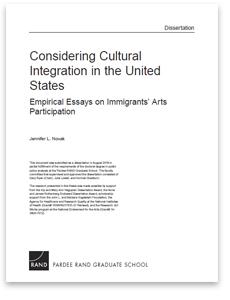
Author: Jennifer L. Novak
Publication Year:
Media Type: Dissertation
Summary:
By 2065, a record-breaking high of 1 in 3 US residents is projected to be either an immigrant or the child of an immigrant. How well immigrants and second-generation immigrants are settling into the US is of great importance to the well-being and vibrancy of the US as a whole. While economic, political, and social facets of immigration are regularly considered for policy-making, relatively little research has examined the cultural and artistic lives of immigrants. Through four empirical investigations, I explore arts participation as a means of broader civic and social engagement facilitating immigrants' integration into the US. [Abstract]
Abstract:
By 2065, a record-breaking high of 1 in 3 US residents is projected to be either an immigrant or the child of an immigrant. How well immigrants and second-generation immigrants are settling into the US is of great importance to the well-being and vibrancy of the US as a whole. While economic, political, and social facets of immigration are regularly considered for policy-making, relatively little research has examined the cultural and artistic lives of immigrants. Through four empirical investigations, I explore arts participation as a means of broader civic and social engagement facilitating immigrants' integration into the US.
First, I consider how arts participation differs between current immigrant generations. Overall, I find immigrants participating at lower rates than US-born citizens, with the notable exception of Latin music activities. I also find second-generation immigrants participating in arts at higher rates than third+ generations in general. These results are consistent with the second-generation advantage theory for immigrant integration.
Second, I explore whether the length of time an immigrant has lived within the US affects their cultural integration with US-born citizens. I find first-generation immigrants residing in the US for longer periods have higher chances of going to see a live musical play or a live jazz performance. However, residence in the US for longer than five years decreases the chances of first-generation immigrants attending live Latin music events. These results align with classical assimilation theory, which posits that over time, first-generation immigrants adopt the practices of mainstream culture in place of their own.
Third, I examine arts participation by non-citizens' legal and undocumented statuses and consider the practical implementation of these statuses in survey data. I fail to find evidence of significant differences between non-citizen legal statuses. This finding empirically suggests that arts participation can serve as a non-threatening means to facilitate integration.
Fourth, I explore how well current survey tools measure arts participation by cognitively testing the Survey of Public Participation in the Arts with individuals in the Chinese immigrant community, providing a needed case study for investigating immigrants within the US more generally. [Abstract]
Arts & Intersections: Immigration
Categories: Cultural Diversity
ADDITIONAL BIBLIOGRAPHICAL INFORMATION
PUBLISHER INFORMATION
Name: RAND Corporation
Website URL: http://www.rand.org